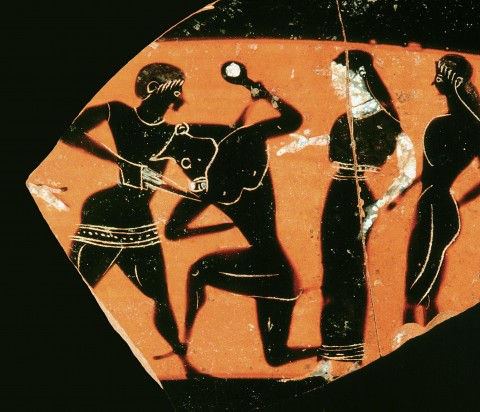Cyclades
The people of the Cyclades, the islands in the middle of the Aegean Sea, fashioned marble statues ranging in size from large to small, the so-called Cycladic idols (APM01872). Most of them represent naked women. Most probably they referred to fertility. Little is today known about this civilization which flourished from around 3000 to 2000 B.C.
Crete
Crete is rather far removed from the Greek mainland. The first inhabitants arrived not until 6500 B.C., when rafts or boats came into existence which could travel such distances.
In the period of the Old Palaces at Knossos and other places (2000-1700 B.C.) a social system developed in which the people handed over their agricultural products to their rulers. The latter then redistributed the goods, giving also the priests, scribes, artisans and military their share. The focal point of the settlement was its political and religious centre, the palace, which also housed the craftsmen who made the most finely worked objects like this jug decorated in the 'barbotine' technique, and the large storerooms for surplus goods. All this demanded careful administration which required a written script. Thus the eastern practice was adopted of writing on clay tablets and of sealing objects like containers with a small lump of clay furnished with a stamped seal or an incised sign. This culture is named Minoan, after the mythological king Minos of Knossos.
The period of the Later Palaces spanned 1700-1450 B.C. and followed on from the destruction of the Old Palaces around 1700. The Later Palaces were larger and had more storeys, with stairwells and light and air shafts. The ground plans of the palaces resemble labyrinths, and archaeological finds reveal that the bull played a major part in religious rituals. This would be the environment in which we would expect to find the origin of the Greek myth of the Minotaur (APM02147), the bull-headed man who lived at Knossos in a labyrinth and to whom seven girls and seven boys from Athens were annually sacrificed until the Athenian prince Theseus, with the assistance of Ariadne, the daughter of the king of Knossos, put an end to the custom.
Mycenae
Around 1550 B.C. the Greek-speaking Mycenaeans, named after their main settlement Mycenae, arrived on the Greek mainland. They were a pugnacious people who often decorated artefacts with martial themes. They built huge citadels from stones which were so large that the later Greeks believed the legendary Cyclopes had constructed them. Visitors to Mycenae were menacingly watched by two monumental lionesses in the relief above the town gate (APM16267). For a long time the Mycenaeans remained a major power in the eastern Mediterranean region. They traded with the Near East, where much of their pottery has been excavated and where they regularly came into conflict with other rulers. The myths centring on the Trojan War – known from the poems of Homer (APM16049) – in which the Greeks were led by the king of Mycenae Agamemnon, are just one example.
The Mycenaeans succumbed to the general difficulties of the thirteenth and twelfth centuries. Later, in about 1100-900 B.C., a time of turmoil and migration began in Greece, the so-called Dark Age.
